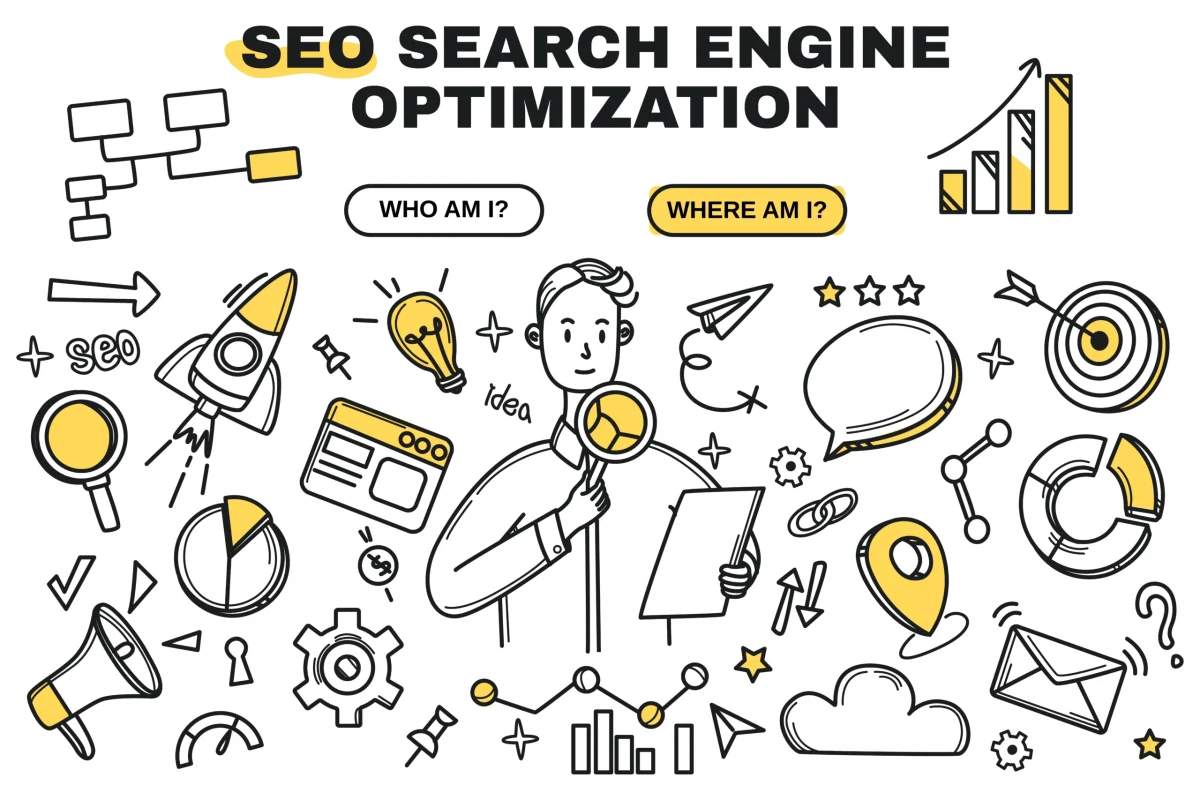SEO, or Search Engine Optimization, is a set of practices aimed at improving a website’s visibility and ranking on search engines like Google. SEO aims to enhance a website’s chances of appearing prominently in search results when users search for relevant keywords or phrases.
This involves optimizing various elements on and off the website to align with search engine algorithms, making the site more attractive and relevant to both search engines and users.
Key aspects of SEO Optimization:-
- Keyword Optimization: Researching and strategically incorporating relevant keywords into the website’s content, meta tags, and other elements.
- Quality Content: Creating high-quality, relevant, and valuable content that addresses the needs and interests of the target audience.
- On-Page Optimization: Improving elements on the website itself, such as meta tags, headings, and images, to make it more search engine-friendly.
- Off-Page Optimization: Building a positive online reputation through link-building, social media signals, and other external factors contributing to a website’s authority.
- Technical SEO: Ensuring that the technical aspects of a website, such as site speed, mobile-friendliness, and proper indexing, meet the standards set by search engines.
- User Experience: Creating a positive and seamless experience for website visitors, as user satisfaction is a crucial factor in search engine rankings.
SEO is an ongoing process, as search engines continually update their algorithms, and competitors may also be optimizing their sites. Effective SEO helps drive organic traffic to a website, ultimately increasing its visibility, credibility, and potential for conversion.

Benefits of SEO (Search Engine Optimization)
- Brings More People to Your Website
SEO helps your website show up when someone searches on Google. If your site is on the first page, more people will click on it. This means you get more visitors without paying for ads. - Free and Long-Term Traffic
Once your site ranks well, it keeps getting traffic for free. You don’t need to keep spending money like in paid ads. Good SEO keeps working even when you are not promoting. - Builds Trust and Credibility
People trust Google. If your website is shown at the top, users feel it is reliable. They are more likely to trust your content or services. - Better Experience for Visitors
SEO is not just about keywords. It also includes fast loading speed, mobile-friendly pages, and easy navigation. This makes your site better for visitors. - Helps You Beat Competitors
If your competitors rank above you, they get more business. But if your SEO is strong, you can rank higher and win more clicks, calls, and customers. - Brings the Right People to You
SEO helps you reach people who are already looking for what you offer. For example, if someone searches “best shoes for walking” and you sell those shoes, you have a better chance of making a sale. - Grows Your Business Without Extra Cost
With SEO, your business can grow naturally. You don’t need to boost every post or run constant ads. It’s a low-cost way to get noticed online. - Useful for All Types of Websites
It doesn’t matter if you have a blog, a small business, or an online store. SEO works for everyone and helps improve visibility online. - Gives Insights About Your Audience
SEO tools like Google Search Console or Google Analytics show what people search for and how they find your site. This helps you create better content and improve your site. - Helps Build Your Brand Over Time
As your site ranks higher and more people visit it, they start to remember your name. This helps build your brand and trust over time.
History Of SEO :-
The history of Search Engine Optimization (SEO) is intertwined with the evolution of the internet and the development of search engines. Here’s a brief overview of the key milestones in the history of SEO:
- The early 1990s: The Birth of Search Engines – The early days of the internet saw the emergence of the first search engines, including Archie, which indexed FTP archives, and later, Gopher and Veronica. These early search tools laid the groundwork for organizing and accessing information on the growing World Wide Web.
- 1994-1997: The Rise of Web Directories and Meta Tags – As the web expanded, webmasters began submitting their sites to web directories like Yahoo! and Open Directory Project. Additionally, the use of meta tags, providing information about a webpage’s content, became a common practice for improving search engine visibility.
- Late 1990s: The Era of Keyword Stuffing and Manipulation – Webmasters quickly realised the importance of being visible on search engines. This led to the practice of keyword stuffing, where websites overloaded their content with keywords to manipulate rankings. Search engines responded by refining their algorithms to provide more accurate results.
- 1998: Google’s Game-Changing Entry – Google was founded by Larry Page and Sergey Brin in 1998, introducing the PageRank algorithm. Unlike other search engines, PageRank evaluated the importance of web pages based on the number and quality of links, revolutionising how search results were ranked.
- Early 2000s: The Emergence of SEO as a Profession – With the growing importance of search engines, SEO evolved into a distinct profession. Companies and webmasters recognized the need to optimize their websites to rank higher in search results, leading to the establishment of SEO as a specialized field.
- Mid-2000s: Algorithm Updates and the Battle Against Spam – Search engines, especially Google, started rolling out major algorithm updates such as Florida, Jagger, and Big Daddy to combat spammy SEO practices. These updates aimed to provide more accurate and relevant search results.
- Late 2000s: Focus on User Experience and Quality Content – Google’s emphasis on providing a positive user experience led to a shift in focus towards quality content. The introduction of the “Caffeine” update in 2009 highlighted the importance of fresh and relevant content for search rankings.
- 2010s: Mobile Optimization and Social Signals – The increasing use of smartphones prompted a shift towards mobile optimization. Google’s Mobile-Friendly update in 2015 emphasized the importance of mobile-responsive websites. Additionally, social signals from platforms like Facebook and Twitter began influencing search rankings.
- 2012-2013: The Knowledge Graph and Hummingbird Algorithm – Google introduced the Knowledge Graph, providing more context to search results. The Hummingbird algorithm update focused on understanding the intent behind search queries, marking a shift towards semantic search.
- 2018 and Beyond: AI, Voice Search, and Core Web Vitals – Recent years have witnessed the integration of artificial intelligence (AI) and machine learning into search algorithms. Voice search has gained prominence, and Google has placed increased importance on factors like Core Web Vitals, emphasizing user experience metrics.
The history of SEO reflects a continuous evolution as search engines strive to deliver more accurate, relevant, and user-friendly results. Keeping up with these changes remains crucial for SEO professionals and website owners seeking to optimize their online presence.







